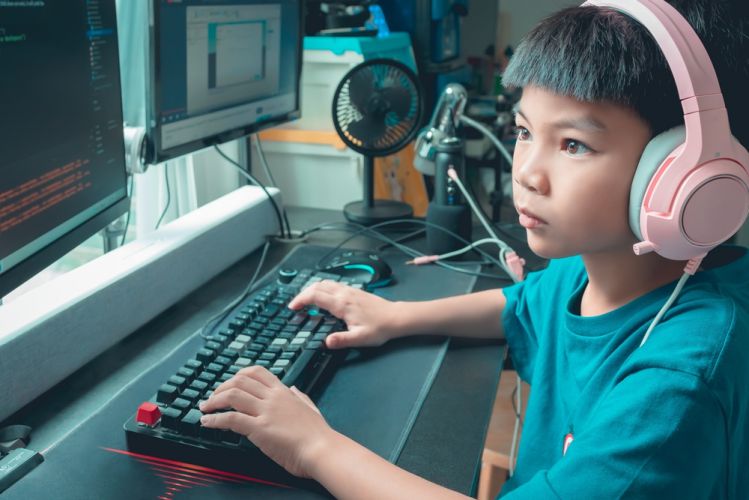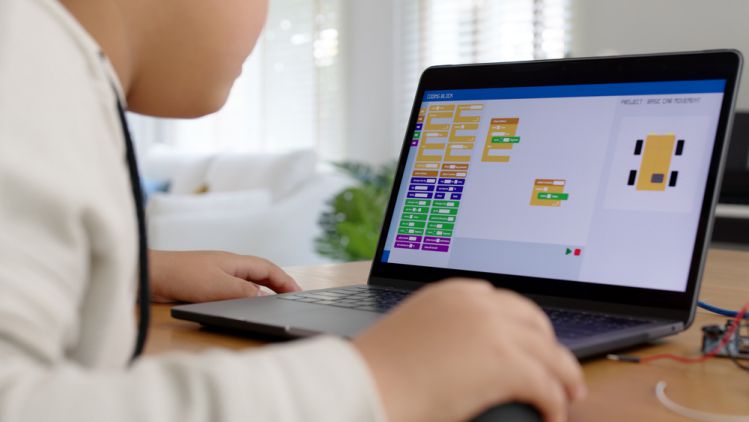From the earliest days of Pong and Tetris, games have captivated our imagination. Today, it’s more than mere entertainment; it’s about constructing digital realities. As children navigate through levels, unlock achievements, or engage with virtual narratives, they don’t just play – they interact with complex programs. Now, imagine the exhilaration when they shift from being players to creators.
In an era where digital interactivity shapes our everyday lives, understanding the essence of game programming holds immeasurable value, especially for the younger generation. Venturing into the domain of game programming for kids can be an exhilarating adventure for children, fostering a fusion of creativity, logic, and problem-solving.

Game Programming to Kids and its Importance
With every virtual dragon slain or every digital puzzle solved, children are unknowingly interfacing with intricate code. They’re not just players in these digital realms but potential architects. Game programming becomes a bridge, turning passive gaming hours into proactive learning experiences. Children get a platform to narrate tales, create challenges, and devise solutions, all while familiarizing themselves with the foundation of the digital age – coding.

Game programming allows them to transition from passive consumers to active creators. Here, they’re not just replicating existing game dynamics but inventing their narratives, integrating their own imaginative twists, challenges, and solutions. It’s about empowering young minds to realize that the digital worlds they so adore can be molded by them.
Principles of Game Programming for Kids
Diving into game programming requires an understanding of its core principles:
- Game Mechanics and Rules: Before a child starts programming, they need to understand the spine of any game – its mechanics. This involves understanding player interactions, movements, and reactions within the game. Defining rules, just as in any sport, is pivotal. Whether it’s how a character gains power or the conditions for winning, setting clear rules is foundational. The thrill of a car racing game lies in its speed boosts, tight turns, and the roar of the engine – all of which need coding. Creating these rules, understanding them, and ensuring they interplay harmoniously is what makes a game enjoyable.
- Character Development: Beyond pixels and graphics, characters have personalities. They have strengths, weaknesses, goals, and challenges. Designing a character isn’t just about its visual appeal but its role and evolution within the narrative.
From the brave princesses to the cunning wizards, characters drive stories. But how do they jump? How do they react when faced with an obstacle? These are behaviors that need to be programmed. A strong character has intricate coding backing its actions. - World Building: Every game is set in a universe, whether it’s the mushroom-laden world of Mario or the intergalactic expanse of Star Wars games. This world has its physics, landscapes, challenges, and secrets. Constructing this is an intricate balance of creativity and logic.
- Storytelling: The soul of any game lies in its story. Whether it’s the tale of a knight saving a kingdom or an alien exploring galaxies, a well-crafted narrative makes a game memorable. Why is a character on a quest? What challenges must they overcome? Crafting this journey with twists, turns, and surprises keeps players engaged.
Teaching Game Programming with Scratch
Scratch, with its vivid, block-based interface, offers a playground-like environment for budding programmers. Every block in Scratch is akin to a puzzle piece, fitting seamlessly to create interactive stories, animations, and games. While it might seem elementary, Scratch embeds complex programming concepts like loops, variables, and event-driven programming in a digestible manner. Its drag-and-drop interface eliminates the intimidation of syntax errors, letting kids focus purely on the logic and creativity of their game. Through Codiska’s Scratch courses, children are encouraged to transform abstract ideas into tangible digital realities.

Teaching Game Programming with Unity
Unity stands as the Everest in the landscape of game programming for kids. While Scratch lays the foundation, Unity challenges kids to climb higher, pushing the boundaries of their coding prowess. Here, they’re introduced to scripting, manipulating game physics, integrating AI, and even dabbling in augmented and virtual realities. With Unity, kids aren’t just designing games; they’re sculpting immersive experiences. Every action, reaction, and interaction in the game has to be meticulously coded using languages like C#. Codiska’s Unity courses are structured to simplify this transition, ensuring that while the learning curve is steep, it isn’t insurmountable.
Ideas for Different Games Kids Can Design
The gaming universe is vast and diverse. Here are some ideas:
The gaming universe is vast and diverse. Here are some ideas:
- Puzzle Games: These engage the brain, challenging players to solve problems, find patterns, or complete sequences. They challenge the player’s intellect at every step.
- Adventure Games: An unfolding narrative where players embark on quests, explore worlds, and overcome challenges. They’re the digital odysseys, where each level is a chapter, each challenge a plot twist, and every character has a role to play in the grand narrative.
- Strategy Games: Here, foresight is crucial. Players must plan, manage resources, and anticipate opponents’ moves.
- Educational Games: Where learning meets fun. Whether it’s math challenges wrapped in an adventure or history lessons disguised as quests, these games make learning interactive and enjoyable.
Encouraging Kids to Start Game Programming and Progressing in It
Fostering a love for game programming involves celebrating small victories, whether a character’s first move on Scratch or a successfully scripted scene in Unity. Encourage sharing, gathering feedback, and constant iteration.

Every child’s journey into game programming is unique. Some might be enthralled by character design, while others might be fascinated by world-building. The key is to nurture this curiosity. Encourage exploration, celebrate small victories, and ensure that every bug or challenge faced is seen as a stepping stone, not a stumbling block. Codiska acts as a guiding beacon, illuminating the path and ensuring every child finds their niche in game programming.
Benefits of Game Programming for Kids
Game programming for kids is more than a recreational activity; it’s a cognitive workout. It sharpens logical reasoning, boosts creativity, inculcates a problem-solving mindset, and nurtures patience. Every bug fixed, every level designed, and every character developed contributes to holistic intellectual and creative growth. Each line of code written and each challenge overcome in the virtual realm equips them better for real-world challenges.
From Gamer to Creator: How Coding Can Change Your Teen’s Life
If your teenager is an avid gamer, have you ever considered introducing them to the world of coding? Learning to code can not only enhance their gaming experience but also open up a whole new world of opportunities. Moreover, coding can also be a creative outlet for your teenager. By learning to code, they can bring their ideas to life and create something that they can be proud of. Whether it’s designing a new game, developing a useful app, or building a website from scratch, coding can provide endless opportunities for your teen to express themselves and showcase their talents.
As technology continues to advance, the demand for skilled coders is growing. By introducing your teenager to coding at an early age, you can give them a head start in a field that is becoming increasingly important in today’s job market. Not only that, but coding can also help your teen develop essential skills in other areas of life. For instance, coding requires attention to detail, persistence, and the ability to break down complex problems into smaller, more manageable tasks. These skills can be applied to a wide range of situations, from academic assignments to personal projects.
In short, introducing your teenager to coding can have numerous benefits that extend far beyond just the world of gaming. By encouraging them to explore the possibilities of coding, you can help them develop valuable skills, open up new career opportunities, and foster their creativity and self-expression. So, why not inspire your teenager to become a creator and see where coding can take them?
Conclusion
Game programming isn’t a mere pastime; it’s a journey of imagination, logic, challenges, and triumphs. In this digital odyssey, children learn more than coding; they discover a world where they can be the creators. And as they embark on this ‘coding for kids’ journey with Codiska, they aren’t just creating games; they’re scripting their own digital narratives, tales that might one day captivate the world.
TL;DR
The TL;DR (Too Long; Didn’t Read) section provides a condensed summary of the article’s main points. For readers seeking a quick overview, this section encapsulates the key ideas and crucial information discussed in the full article. Codiska recommends reading the TL;DR section for a quick overview of the article.
- Game programming helps children turn passive gaming hours into proactive learning experiences
- Understanding game mechanics, character development, world building, and storytelling are essential principles of game programming for kids
- Scratch is a great tool for teaching game programming to kids
- Unity challenges kids to push the boundaries of their coding prowess and provides them with an opportunity to sculpt immersive experiences
- Puzzle games, adventure games, strategy games, and educational games are some ideas for the different games kids can design
- Encouraging sharing, gathering feedback, and constant iteration can help kids progress in game programming






